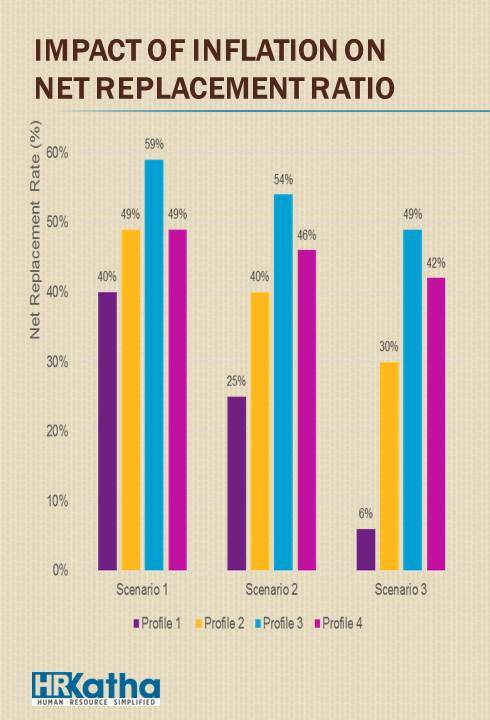The next decade or two may see retirees in India facing the challenge of inadequate incomes.
The Central Government of India currently employs around 47 lakh people, but the number of pensioners under it is 52 lakh.
For these pensioners, there has been a sense of security post retirement. However frugal it may be, the pension that retired government employees receive, helps them meet their basic needs. The other government schemes, such as CGHS, take care of their medical needs to some extent.
However, now that the size of the workforce employed with private organisations is expanding rapidly, it is high time India wakes up to the future crisis of post-retirement survival.
In fact, it is estimated that in the next decade or two, India may have to face the biggest challenge of retirees having inadequate incomes.
Just imagine, the size of the Indian workforce is around 49 crore, 94 per cent of which works in the unorganised sector. Of the 6 per cent who work in the organised sector, a whopping number are employed with the private sector, where there are no retirement benefits apart from the mandatory benefits, such as provident fund and gratuity, which are certainly not sufficient.

As per a survey by Willis Towers Watson Global Benefits Attitudes Survey 2013/14, millennials in India feel they are less likely to be better off in retirement than their parents.
Increasing consumerism, spiralling medical and education expenses, inflationary pressures and a weakening joint family system are some key reasons for this concern.
A few years back, a joint family system coupled with defined benefit pension schemes offered by employers supported people through retirement. With the trend of nuclear families and a conscious shift by employers to defined contribution schemes (that are generally supplementary programmes), employees have been left with limited support.
Hence, the responsibility of saving a sufficient corpus for one’s old age largely falls on the individuals themselves — a considerable task considering escalating living costs and increasing longevity.
Kulin Patel, director, Willis Towers Watson India, says, “Despite Indians saving more than their counterparts in the western world, there is lack of awareness, unrealistic assessment of what to expect on retirement and a short-sighted approach to retiral savings.”

The Willis Towers Watson study indicates that retirement expectations are overly optimistic and are typically framed by current norms rather than a realistic assessment of what employees can expect on their retirement. Current expectations do not model the future scenarios adequately.
Approximately two in five respondents in India see rising cost of living and contingency of emergency costs, as the most significant risks when it comes to adequacy of retirement savings.
Willis Towers Watson has devised a modelling technique quantifying the impact of inflation, living expenses and return on assets on the Net Replacement Rate (NRR), which is an effective measure for adequacy of post-retirement income. NRR is the percentage of an employee’s post-tax pre-retirement income, paid through post-tax post-retirement annuities (including employer-sponsored programmes).
For instance, for a 22 year old with an annual package of Rs 3.6 lakh, a 100 basis point increase in inflation can lead to an approximate 20 per cent drop in the NRR and an approximate nine-year decrease in income sustainability in retirement. He will need an NRR of at least 40 per cent to be able to sustain for a minimum of 19 years in retirement.
Similarly, for a middle management profile— around 35-40 years— with an annual package of Rs 30 lakh, a 100 basis point increase in inflation can decrease the NRR by 3-5 per cent approximately, whereas a 200 basis point increase in inflation can almost double the decrease in the NRR to about 8–10 per cent .
While there is no measure of the most appropriate NRR, based on global experience, a 55 – 65 per cent NRR can be considered reasonable.
In such a scenario, employers should use retirement planning tools to understand the effect of their retirement plans on the overall savings of their employees and also play a key role in educating them.
Employees are turning towards their employers for support in financial wellness and long-term retirement planning. Employers should reciprocate by creating awareness through effective communication. A simple, timely and personalised message will alert employees to rethink their financial well-being.
Value our content... contribute towards our growth. Even a small contribution a month would be of great help for us.
Since eight years, we have been serving the industry through daily news and stories. Our content is free for all and we plan to keep it that way.
Support HRKatha. Pay Here (All it takes is a minute)





































This is a real issue. People must start saving in NPS.
Teach your Children value of ethics and moral.Give then adequate dose of love affection and dedicated attention.Avoid wastage at every stage.Consider wastage a National Waste even if you have paid for it.Limit your desires at every station of your life.Eat to live and don’t live to eat.Be contended and you will live your life comfortably till you breath your last.Do not worry and waste your today.